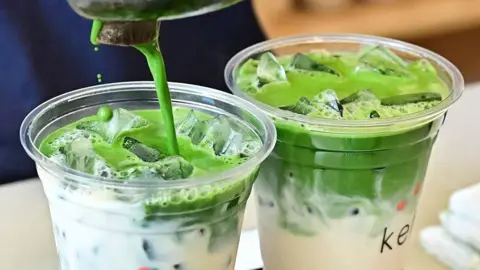### The Rising Demand for Matcha
The world is experiencing a significant increase in the popularity of matcha, the vibrant green tea that has transcended its traditional Japanese roots to become a global sensation. This enthusiasm for matcha is palpable across various aspects of daily life, from Starbucks lattes in the United Kingdom to Krispy Kreme donuts in Singapore. However, the explosive demand for matcha is putting immense pressure on global supplies, leading to issues that could affect pricing and availability.
The roots of this matcha popularity surge can be largely attributed to the impact of social media. Influencers and food enthusiasts are actively sharing brewing techniques, recipes, and reviews, catalyzing the “Matcha Tok” movement, which has garnered millions of views and fostered a community of matcha enthusiasts. Furthermore, Japan’s tourism revival in the post-pandemic era, along with the weak yen, has not only attracted tourists to Japan but has also stimulated interest in Japanese products, including matcha.
### An Escalating Demand
The demand for matcha is soaring at an alarming rate. Lauren Purvis, a tea importer from the United States, reported to the BBC that her clients are witnessing what typically used to be a month’s supply of matcha depleting within just a few days. Some cafes are reportedly requesting a kilo every day, indicating a high level of urgency to meet consumer expectations. While this skyrocketing demand carries the potential for economic benefits to suppliers, it also comes with the downside of rising prices, a phenomenon exacerbated by adverse weather conditions and trade tariffs imposed by the U.S. on Japan.
### The Matcha Production Process
Traditionally, matcha is celebrated for its health benefits and unique flavor, produced through a meticulous, centuries-old process. It is derived from tencha, the green tea leaves that undergo shading in their final growing phase to develop their characteristic umami flavor. Following harvesting, those leaves are dried and ground into fine powder using stone mills, a process that is labor-intensive—yielding only about 40 grams of matcha per hour.
However, recent months have posed significant challenges for matcha growers, particularly in Japan’s Kyoto region, which produces approximately 25% of the country’s tencha. Record heatwaves have led to subpar harvests coinciding with the rising demand, creating a perfect storm for shortages. Additionally, Japan is grappling with an aging farming population, further complicating the supply situation.
### A Shift in Consumer Behavior
In response to the ongoing shortages, matcha retailers have started imposing purchasing limits on customers. Notable establishments, such as Kyoto’s Camellia Tea Ceremony, have restricted sales to ensure wider access for tourists and local enthusiasts alike. Following a spike in visitor numbers, director Atsuko Mori revealed that customers can only purchase one tin of matcha each.
In Tokyo, tea ceremony chains are also affected; Rie Takeda, a tea master at Chazen, reported that typical restock times have increased from days to over a week, forcing her to closely manage inventory. Prices of matcha have risen significantly, with estimates suggesting a hike of about 30% this year.
### Mindful Consumption and Future Trends
Parallel to rising consumer demand for matcha, there is an emerging movement advocating for more mindful consumption. Experts urge consumers to avoid hoarding and to appreciate matcha in its purest forms rather than using it primarily in recipes or stockpiling it for later resale. Such sentiments are reflected in discussions among industry leaders who emphasize the rich cultural significance of matcha and its scars when treated merely as a commercial product.
The Global Japanese Tea Association is promoting the use of lower-grade matcha from later harvests, which is more abundant and suitable for culinary purposes. This initiative seeks to preserve the integrity of high-grade matcha while ensuring that the broader community can continue to enjoy this treasured beverage.
Despite the challenges posed by rising prices, experts believe that there is hope for easing supply constraints in the future. Many anticipate that while demand is currently booming, it may stabilize within two to three years as the market adjusts to shifts in consumer habits and supply chain realities. As matcha captures the hearts of a global audience, balancing respect for tradition with contemporary demand will be crucial for its sustainability.












